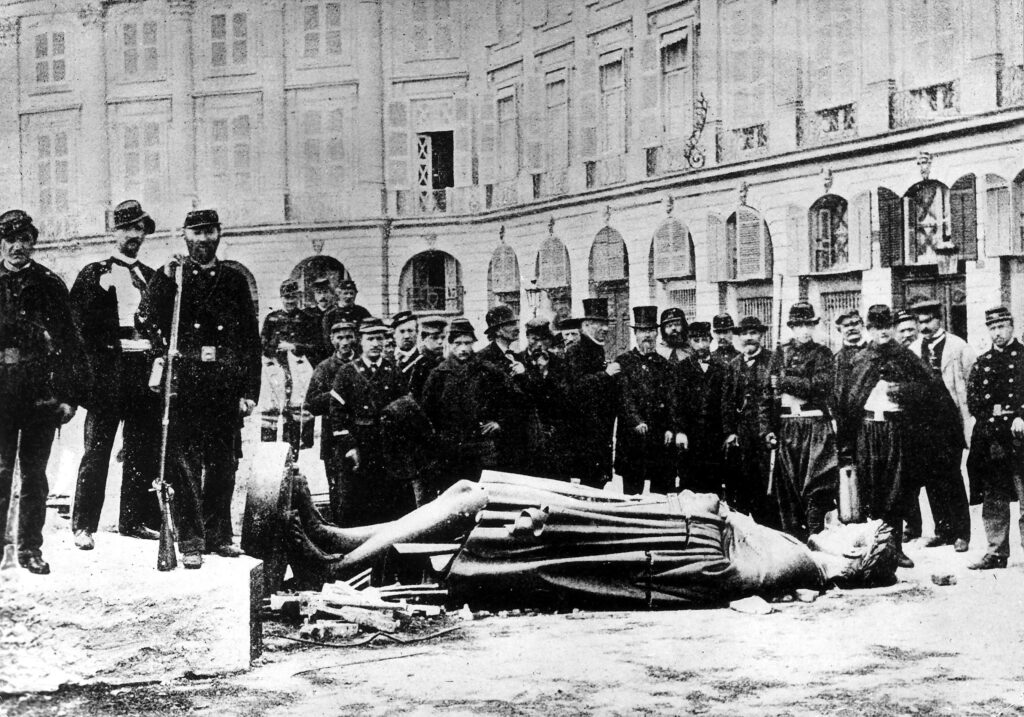Share Twitter Facebook Email Copy URL
150 years ago, the world witnessed the emergence of the first-ever worker’s republic
Not so long ago, the spot where today Sacré-Coeur—the basilica nicknamed the “Alabaster wedding cake”—now stands atop Montmartre in Paris, was once an insalubrious neighbourhood, home to proletarians, day labourers, and sex workers. It was also the birthplace of what Karl Marx saw as a harbinger of things to come: the Paris Commune. One-and-a-half centuries ago, it was here, perched at the top of Montmartre, that its residents stationed artillery they had acquired through community donations to defend themselves against the Prussian army’s siege of Paris. The French government’s attempts to disarm its people had led to acts of resistance in working-class neighbourhoods. The government fled to Versailles, and the remaining workers, intellectuals, and day labourers in the city were tasked with organizing the capital’s defence, its everyday life, and the foundations of an entirely new social structure.

It was here in the spring of 1871 that humanity took an irreversible step forward on the path towards its own emancipation. The events experienced by the Communards of Paris informed both the lyrics of “The Internationale” and the political praxis adopted by the Bolsheviks in Russia. As both corrective and inspiration, these experiences were also instrumentalized in order to legitimize state-socialist domination. In order to glean lessons from the history of the Paris Commune that retain relevance for political action in the twenty-first century, this history must first be understood and then critically evaluated with respect to its contemporary relevance. In this spirit, it is helpful to train a new kind of ear to the experiences voiced by the Communards and try to learn from what they have to say.
The Background of the Commune
The Paris Commune was established on 18 March 1871, but its roots can be traced right back to 1848, when a wave of democratic revolution originating in France washed across the European continent; in Vienna, Warsaw, Rome, and Berlin, people took to the streets in protest.
In France, the democratic revolution was defeated in a matter of months, ending with the bloody suppression of a workers’ revolt protesting against the closure of the national workshops in June 1848. Despite this, the street fighting of this period laid the foundations for the establishment of an autonomous French workers’ movement, which operated independently of the centrist bourgeois political parties—a key prerequisite for the formation of the 72-day-long “Republic of Workers” in 1871.
Following the defeat of the uprising, however, a military dictatorship initially asserted control, before handing the reins to Napoleon III a few months later. As Marx set out in The Civil War in France, the coronation of Napoleon Bonaparte’s nephew thus represented less a triumph of capitalist hegemony than it did the establishment of an authoritarian regime aimed at suppressing a working class that was growing in strength.
East of the Rhine, in a fragmented Germany, monarchic powers were also able to put down revolutionary efforts and defeat the democracy movement. The latter’s demand for German national unity was subsequently co-opted “from above”, redefined and positioned as a project designed to suit the Prussian-led response.
The policies pursued by the Prussian crown were geared towards preserving monarchic power while also seeking to unify Germany. In particular, the incorporation of Southern German states into this process of nation-state formation was bound to spark resistance in France, which had no interest in seeing a unified and strengthened Germany. Following the victory of Prussian-led troops in the so-called “Wars of German Unification”, the conflict between French and German interests once again resumed centre stage, and only continued to intensify. This was a clash between two rival powers who, seeking to preserve and expand their spheres of influence both at home and abroad, had already been firmly set on a collision course with one another. In the summer of 1870, Prussia’s Minister President Otto von Bismarck succeeded in provoking the government in Paris to declare war by publishing a deftly distorted account of a meeting between the French ambassador to Prussia and the Prussian king (the “Ems Dispatch”), and thus ensuring they were the ones deemed responsible for inciting the war.[1]
Shortly thereafter, August saw the first hostilities of the Franco-Prussian War break out, with the French assault on Saarbrucken. A few days later, Prussian troops had crossed the Rhine. The beginning of September was marked by the Battle of Sedan, which resulted in the capture of France’s last combat-ready field army units along with Napoleon III as prisoners of war. This sudden defeat sealed the fate of the Second French Empire, but did not signify the end of the war, with the Prussian troops marching onwards towards Paris with the aim of capturing it.
Following the defeat at the Battle of Sedan, the Third Republic was proclaimed in Paris, despite a complete lack of democratic legitimacy. Although the empire’s political and military failures meant it had been discredited, the Republic did not act to remove the monarchy. According to Marx, the measures taken by the government were evidence that they had “inherited from the empire not only ruins, but also its dread of the working class”.
The ongoing situation in and around Paris also offered little encouragement to those hoping to found a free republic, either. By the beginning of October 1870, Paris was under total siege, beset on all sides by Prussian forces, and attempts to break the siege line with troops from the provinces had also failed. At the end of January 1871, Jules Favre, minister of foreign affairs for the Provisional Government of National Defence, signed an armistice with the newly formed German Empire, which had been officially proclaimed just ten days earlier in the Hall of Mirrors at Versailles. The armistice treaty stipulated that only a freshly elected National Assembly would have the power to ratify an eventual peace treaty. The assembly first met on 12 February in Bordeaux—far removed from the nation’s capital, which remained in a state of total siege by German troops—and elected as minister president a proponent of constitutional monarchy in the form of Adolphe Thiers. Favre, who had brokered the armistice, remained in his post as foreign minister.
In Paris, both the choice of location for the National Assembly as well as the make-up of the new government were viewed as betrayals of those who had spent months defending the capital against the siege. After Prussian forces had begun retreating from Paris in early March, and the new French government set about disarming the National Guard troops in Paris, resistance to these actions began to grow, coming to a head on 18 March 1871.
“The People’s Cannons”: 18 March 1871
In order to defend Paris against the German troops, in September 1870 the Thiers-led government had reorganized the National Guard and enlisted unemployed men into its regiments. This led to a change in the military’s demographic character; National Guard soldiers deposed their officers, elected new commanders from within their own ranks, and also established their own governing body, the Central Committee of the National Guard. This laid the foundations for the founding of a people’s army in Paris and effectively established a dual power structure, with the French government on one side and the National Guard on the other.
On the evening of 17 March, the government’s inner circle resolved to seize the National Guard’s artillery as a means of neutralizing the Central Committee’s power and consolidating their own. In service of this plan, the government published a statement which slandered the Central Committee and painted it as a danger to the young French Third Republic. Not wanting to rely solely on the desired effect of this statement, on the morning of the 18th they gave orders for troops to march towards Paris and stage a surprise attack against the National Guards’ positions, securing the artillery installations for the government’s arsenal in the process. Meanwhile, the residential districts began to wake up in the morning and their inhabitants saw what was happening on the streets in front of them. An eyewitness wrote: “As on other major occasions, the women led from the front. Those present on 18 March … did not wait for their husbands. They encircled the mitrailleuses [a cannon-shaped volley gun, somewhat similar to a rudimentary Gatling gun] and cried out to the gunners: “‘This is shameful; what are you doing there?’ The soldiers did not answer.” As time passed, larger groupings of National Guard troops arrived on the scene. Atop Montmartre, General Lecomte ordered the government soldiers to open fire on the men and women. They refused, however, instead mingling with the National Guard troops and arresting the general. At other locations around the city, the National Guard troops and the local populace were able to prevent the canons’ removal. Over the course of the morning, the people of Paris were thus able to repel the attack, securing almost all of the cannons and acquiring thousands of additional firearms.
Having failed to capture the cannons and surprised by the workers’ resolve, Thiers decided to decamp the capital and head to Versailles, accompanied by his government and loyalist army regiments. That they were able to flee the city with ease was due to the fact that the National Guard battalions—anticipating a renewed attack by government forces—had barricaded themselves in their neighbourhood strongholds or otherwise directed their movements to avoid a confrontation.
As the sun set over Paris that evening, power in the French capital essentially resided on the streets. Given this situation, the National Guard’s Central Committee decided to cobble together a provisional government. The majority of the Parisian population first learnt of the shift that had occurred in their city the following morning, when the Central Committee occupied the Hôtel de Ville, raised a red flag, and addressed the city’s residents with their first proclamation:
You charged us with organizing the defence of Paris and of your rights.
We are conscious of having fulfilled this mission: aided by your generous courage and your admirable calm, we have chased out the government that betrayed us.
At this time our mandate has expired, and we yield it, for we don’t claim to be taking the place of those who a revolutionary wind has just overthrown.
So prepare and carry out your communal elections, and as a reward give us the only one we ever wished for: seeing you establish the true republic.
In the meanwhile, in the name of the people we will remain at the Hôtel-de-Ville.
The Social Democracy of the Commune
The provisional government’s first official act was publishing a call for elections to determine the make-up of the Commune Council. The revolution of the previous day had laid the foundations for a French republic that would permanently “mark the end of the era of invasions and civil war”. Additionally, the Central Committee saw itself as the force that had defended Paris and one which would now return control of the city to its residents through the council elections.
The election took place less than ten days later, on 26 March; just two days later, the Paris Commune officially came into being. Given the urgency of organizing an election within such a short timeframe, there was scant discussion about the Commune’s actual political programme in those first few days. For this reason—according to Prosper Lissagaray, himself a Communard—votes were primarily cast based on name recognition. Consequently, the Commune Council ended up comprising a colourful mixture of Jacobins, socialists, anarchists, Romantics, and representatives of the bourgeoise opposition to Napoleon III. This meant that the Commune included powerful factions that took their political inspiration from the concepts of the bourgeoise French Revolution of 1789 right alongside proto-socialists, anarchists, and Marxists. This diversity of political positions was reflective of the century of class struggle that had preceded the founding of the Commune.[2]
Due to the growing animosity emanating from Versailles and the increasingly clear and specific demands made by the workers’ districts, 16 elected representatives stepped down from their posts during the Commune Council’s first meeting alone, as they were unwilling to participate in a committee structure that sought to operate at a level above that of a city council. These withdrawals and the results of the subsequent by-elections of 16 April led to a strengthening of the socialist agenda within the Commune. Nevertheless, the council remained shaped by individuals who adhered to a range of competing ideologies, occasionally leading to conflict. As a result, many of the Commune’s political positions and policies remained somewhat vague.
At the same time, however, the collaborative nature of the collective efforts to defend the newly established order in Paris was one of the Commune’s strengths. Any evaluation of the Commune Council should not overlook the fact that, given that it only existed for just under two months—from 28 March to 25 May—the time that its members had available to realize their political agendas was extremely limited. Beginning on 2 April, government troops set out from Versailles to launch an offensive on the capital, forcing the Commune into a war. Despite the urgency of the situation, the Commune Council was able to enact a number of important decrees aimed at bringing about fundamental social change. The following policies are particularly worthy of mention:
- A waiver on rents for the period October 1870 to April 1871
- A ban on the sale of items of property pledged by citizens during the siege
- The dissolution of the standing army and its replacement by arming the populace
- Free public education
- Wages for civil servants to be made reflective of the average worker’s wage
- The takeover of abandoned factories by worker-controlled co-operatives
- The seizure and redistribution of unoccupied housing
- A ban on punitive fines and the docking of wages and salaries
- A ban on night shifts for apprentice bakers
- The establishment of a fixed price for bread
These measures were primarily a reaction to the living situation in Paris. Beyond meeting these immediate needs, however, they were intended to pave the way for the constitution of a social republic shaped by workers and tradespeople that prioritized their interests.
Above all, the council’s most revolutionary acts were the decrees designed to democratize the city’s organizational structures. These included the limiting of wages for representatives and civil servants and the stipulation that officials could be recalled and re-elected at any time (known as the imperative mandate). Admittedly, given the particular conditions of war and siege that the Commune was operating under, any and all of the measures it enacted could ultimately be little more than “patchwork [actions], or aspirations for the future”.[3] At the same time, they clearly set out how a community can be organized along properly democratic lines, wherein as much of the population as possible is able to participate in the shaping of the conditions under which they live. In this respect, the most important measure enacted by the Paris Commune was the functional nature of its very existence.
The Women of the Commune
The Commune’s political praxis was determined in large part by the numerous political clubs, district committees, and the battalions of the National Guard, all of whom bore strong influence on the activities of the Commune Council—along with the organizations set up by the women of Paris, who played an active role in shaping and defending the Commune and fought for the ability to participate equally in social life.[4]
The memoirs of famous Communard Louise Michel depict daily life in the Commune. Her text is also a paean to the women of the Commune, who she reports were “more capable than the men to say definitively that is has to be this way. Although inside they may feel shaken to their very core, they remain outwardly serene. Shorn of hate, of rage, of sympathy for either themselves or for others, they insist it has to be this way, even if it makes the heart bleed. That’s what the women of the Commune were like.”[5] Michel was thus of the conviction that the enemies of the Commune would have had much less difficulty recapturing Paris had the Commune had as many opponents amongst the city’s women as it did amongst the male population.
Michel’s depiction underscores the crucial role that women played in the shaping of the Commune and the struggle to protect it. One of the reasons for this is that the organization of provisions and fuel—tasks which typically fell to women—were of enormous importance for the maintaining of daily life under the Prussian siege. This resulted in the formation of (female) networks in local communities that became conduits for the politicization of Parisian women. To put it another way: the city’s women were directly affected by the hardships of war, but also beneficiaries of the Commune’s decrees. Their resulting alignment with the overall political project was thus driven less by abstract theoretical considerations and more by their own concrete interests.
The women of Montmartre in particular made a name for themselves, in no small part due to the speeches on women’s rights they prepared and delivered at events hosted by the political clubs. Alongside this, they tended to the practical necessities of daily life and the defence of the Commune, although they were more than willing to express their criticism of it as well. The decision of the National Guard’s high command to ban women from participating in battle, for example—whether as soldiers or as medics—was met with resolute opposition among women. They rightly identified this as an instance of discrimination and a betrayal of the principles of the Commune, and thus something that endangered the project as a whole.[6]
Independently of the positions they took in various internal disputes, the women of the Commune struggled more broadly for the implementation of a form of communal life founded on solidarity and gender equality in Paris as a whole and beyond. In the ranks of the Commune, they discussed, fought for, and died in service of this goal. Their work was most unsettling for the proponents of the old order, who were unrestrained in their attempts to defame female Communards as viragoes or even furies. But a number of male Communards were also made uncomfortable by these self-assured women, as their behaviour disrupted established gender roles within society—which was reflected in the fact that female Communards were denied the right to vote in elections. The increased visibility and actions of women in the Paris Commune signify an important step forward in the struggle for gender emancipation: while the male Communards needed to come to accept women as comrades in a shared struggle, the female Communards had to learn to free themselves from traditional gender-based stereotypes.
Taken as a whole, it is evident that the Paris Commune was a snapshot of the various groups active within the Republican movement in France, in which the socialist workers’ movement was an important group, but not the largest one. The most strongly represented group on the Commune Council consisted of men who saw themselves as a continuation of the radical forces active in the French Revolution. This naturally led to frequent conflicts which, given the urgency of the decisions that had to be made in Paris, exploded with great vehemence. It can thus be seen as a great strength of the Commune that these conflicts never boiled over to the point where Communards lost sight of their shared goal: the establishment of a social and democratic republic.[7] On the basis of this fundamental commonality that bound the various revolutionary forces present in Paris, the sturdiness of traditional political concepts could be tested in the arena of social reality and, if necessary, cast aside or modified; alongside this, new political forms emerged that provided a possible framework for overthrowing capitalism and establishing a society built upon solidarity.
The Fall of the Commune
After the government troops from Versailles had begun their offensive on Paris on 2 April, the Commune was forced to defend itself against daily attacks from fresh units that had been brought to Paris from across France and notably also prisoners of war who had recently been set free by the Germans. Amidst heavy fighting, control of the towns, buildings, and fortifications surrounding Paris changed hands many times. On 21 April, however, the troops from Versailles made their decisive strike on Paris. Following weeks of heavy artillery bombardment, the city’s fortifications lay unoccupied, and the Commune’s enemies were met with little to no resistance as they entered the city. Following this incursion, the remaining Communard forces barricaded themselves in their local neighbourhoods, where they resisted the Versailles troops’ advance as fiercely as they could. Although this approach corresponded with the central priority of the majority of the National Guard—protecting their own neighbourhoods and families from the advancing enemy—it meant that the Commune lacked a co-ordinated form of leadership.
Over the next seven days, the troops from Versailles conquered Paris, overcoming dogged Communard resistance, street by street, barricade by barricade. Whenever they captured a Communard position, the Versailles death squads swung into action, rounding up all surviving resistance fighters and summarily executing them. Communard Prosper Lissagaray described the actions of the victorious army as an abominable slaughter, one which exceeded the scope of the St. Bartholomew’s Day massacre in a matter of hours. One week later, on 28 May, the last shot was fired from a Commune-held cannon. “The piece, charged with double shot, with a terrible crash exhaled the last sigh of the Paris Commune. The last barricade of the May days was in the Rue Ramponeau. For a quarter of an hour a single Federal defended it. … At eleven o’clock it was all over.”
On 29 May, Adolphe Thiers declared that order had been restored to Paris. But the end of Communard resistance did not mean an end to the killings; until mid-June, the execution of defeated Communards was a daily occurrence. As this was happening, eyewitness Lissagaray describes, wealthy Parisians took the opportunity to re-assert control of “their” city:
Since the Thursday this kid-glove populace followed the prisoners, acclaiming the gendarmes who conducted the convoys, applauding at the sight of the blood-covered vans. The civilians strove to outdo the military in levity. … Elegant and joyous women, as in a pleasure trip, betook themselves to the corpses, and, to enjoy the sight of the valorous dead, with the ends of sunshades raised their last coverings.
The exact number of those who fell victim to this bloodshed remains unknown, as the bodies of most of those killed were hastily buried or burned. It is clear, however, that during the “Bloody Week” in May, no fewer than 30,000 Communards were killed or murdered.
In reckoning with the French state’s actions concerning the Commune, it is important to also highlight that even after the mass executions had ended, a further 9,000 Communards were sentenced to either imprisonment or exile. In the forts along the French Atlantic Coast, but above all in the penal colony on New Caledonia—known as the “dry guillotine”—Communard resistance fighters died in great numbers, before an amnesty declared in 1880 permitted survivors to return to their homeland.
The amnesty, however, was no rehabilitation; the sentences received by the Communards retained their legal validity, and to this day French authorities have staunchly refused efforts to have them revoked. This means that the Communards retain the status of political criminals. The intent here is clear: to delegitimize the Paris Commune. In this sense, the depiction of the aforementioned events published in an 1881 issue of the German magazine Der Sozialdemokrat to commemorate the tenth anniversary of the Commune’s defeat remains as apt as ever. A sea of blood separating two worlds; on the one side, those who struggled for a different and better world, and on the other, those who sought to preserve the old order.[8]
The Commune’s Ongoing Relevance
While in Paris the battle to defend the Commune was still raging, August Bebel asserted the radical German social democracy movement’s solidarity with the resistance fighters. Speaking in the Reichstag, he declared that during those days, “the entirety of the European proletariat and anyone who still believes in the importance of freedom and independence” had their eyes trained on Paris. Bebel was unstinting in his support of the Paris Commune and expressed his conviction that “the most important events in Europe’s history are still ahead of us; it is a matter of decades before the Paris Commune’s rallying cry of “War on the palaces, peace to the huts, death to poverty and to indolence!” will become that of the entire European proletariat.”[9] The Commune was met with a similarly positive response in many other parts of Europe as well.
But as the social-democratic movement gradually turned its back on its revolutionary roots, its commemoration of the Commune also receded into the background. In contrast, the Communist movement that emerged from the October Revolution in Russia saw the Paris Commune as part of its heritage and made sure to keep its memory alive. Vladimir Lenin is famously said to have danced in the snow on the 73rd day of the Bolshevik government, marking the moment it had succeeded in outliving the Paris Commune. At the same time, however, the October Revolution and what followed signified the emergence of a new and seemingly successful model of socialism on the world stage, one which shifted the focus of Communists from the Commune to “Red October”.
Following the collapse of state socialism in Europe, all prior attempts to overthrow capitalist social relations by means of revolution were left severely discredited. One of the historic lessons that the Communist parties took from the Commune was not to underestimate the issue of power as the Communards had done. Instead, they made the inverse mistake, concentrating exclusively on maintaining power.
If we are to make another attempt at realizing socialism today, the failure of the Soviet model makes it utterly clear that it can only be done with the democratic participation of the people. Democratic structures and means of control will only be able to succeed, however, if the legitimacy of decision-making is tied to processes that are democratic in the most fundamental sense. One example of such that comes to mind is the use of the imperative mandate, as practiced by the Communards in 1871.[10] Thus, any collective attempt to forge a pathway to a society based on solidarity and socialist principles requires thorough engagement with the experiences of the Paris Communards. Their goal, to found a “democratic and social republic”, still awaits its true realization.
[1] See episode two of the Rosalux History podcast, “Von Bismarck zum Treuhandtechno”, September 2020.
[2] For a more in-depth discussion of this, see: Grams, Florian: Die Pariser Kommune – Basiswissen. 3rd ed. Cologne 2021, pp. 45ff.
[3] Haupt, Heinz-Gerhard and Hausen, Karin: Die Pariser Kommune – Erfolg und Scheitern einer Revolution. Frankfurt/M. 1979, p. 172.
[4] See Hartmann, Detlef and Wimmer, Christopher: Die Kommunen vor der Kommune 1870/71. Hamburg 2021, p. 121.
[5] Michel, Louise: Memoiren – Erinnerungen einer Kommunardin. Münster 2017, p. 135f.
[6] See Schrupp, Antje: Nicht Marxistin und auch nicht Anarchistin – Frauen in der Ersten Internationale. Frankfurt/M. 1999, p. 177.
[7] See ‘Erklärung der Minorität des Kommune-Rats vom 15. Mai 1871’, quoted in: Swoboda: Die Pariser Kommune, loc. cit., p. 243.
[8] See ‘Gedenktage des Proletariats: Die blutige Maiwoche’, in Der Sozialdemokrat, Issue 21, 22 May 1881, p.1.
[9] Bebel, August: ‘Die Pariser Kommune – Vorpostengefecht des europäischen Proletariats’. From his speech to the Reichstag in opposition to the annexation of Alsace-Lorraine of 25 May 1871, in: Ausgewählte Reden und Schriften Bd. 1: 1863-1878. Berlin, 1970, p. 150.
[10] See Sohn, Manfred: Der dritte Anlauf – Alle Macht den Räten. Cologne, 2012, p. 110.
Florian Grams is a historian and author of the book Die Pariser Kommune (PapyRossa, 2021). He lives in Hanover. Translated by Ryan Eyers and Joel Scott for Gegensatz Translation Collective. The article was first published on rosalux.de.



